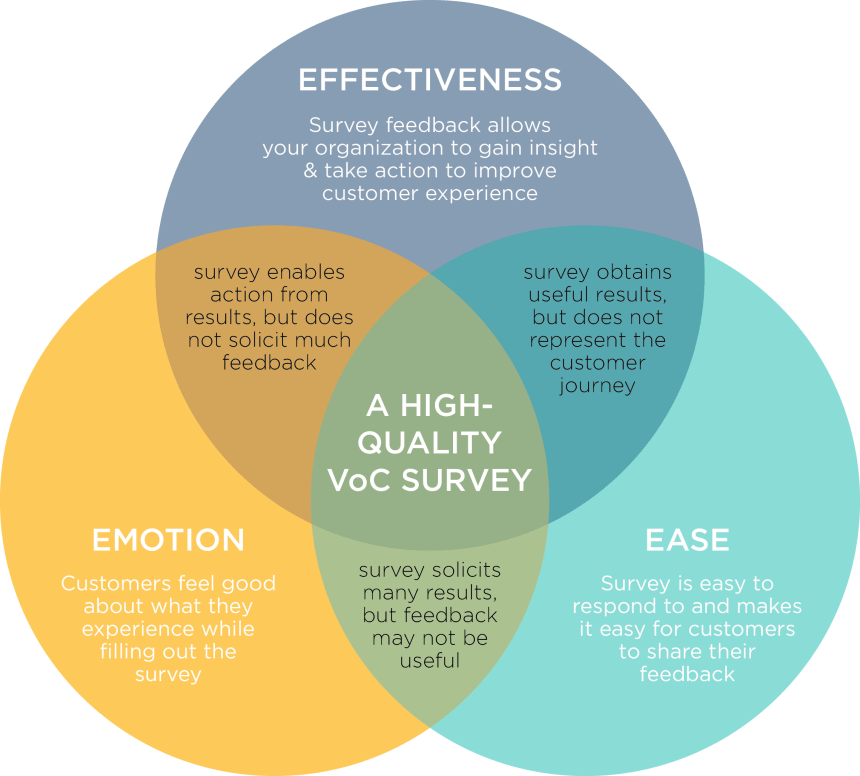
June 13, 2016 | InBrief
Developing a quality survey for your VoC program
Developing a quality survey for your VoC program
Very few people have never been asked by a company to provide feedback. Customers can barely visit a website or speak to a service rep over the phone without being prompted to fill out a customer experience survey. Seattle-Tacoma International Airport even has a survey kiosk to collect facility satisfaction data.
All jokes aside, the fact remains that the data companies can attain from surveys provides invaluable insight into how companies can improve their product, experience or brand in the eyes of customers. In a previous blog post, we’ve highlighted these benefits among others customer feedback and a Voice of the Customer program can bring. However, the potential benefits depend entirely on the quality of the survey.
Developing a quality survey mirrors creating a great customer experience. We measure survey quality on a 5-point scale with three criteria: Effectiveness, Ease, and Emotion. Effectiveness is how well the survey solicits feedback useful in achieving the stated goals of the survey. Ease measures the customer effort exerted to complete the survey. The last criterion, Emotion, is how well the survey provides a connected and empathetic customer experience for those completing the survey. Please see our assessment framework below.
Survey Assessment Framework
Effective: was the survey effective in capturing customer feedback and sentiment?
-
1 – Mostly asked questions irrelevant to the experience, internally focused
-
3 – Neither effective, nor ineffective
-
5 – Focused on what mattered most to the experience, customer-centric
Ease: was the survey easy to navigate (access and minimized clicks) and understand?
-
1 – survey was >15 questions, required >3 clicks to access
-
3 – 10-15 questions, 2-3 clicks to access
-
5 – <=5-10 questions, 1 click or less to access
Emotion: how much did the customer connect with and feel heard from the survey?
-
1 – Cold, unenjoyable experience, not dynamic or no ability to provide more open-ended answers
-
3 – Neither enjoyable or unenjoyable, standard survey template, no personalization
-
5 – Customer-centric, provided value to customer, dynamic, personalized
In reviewing hundreds of surveys across various industries, we’ve found most really stink. They are ineffective, cumbersome or dispassionate. Even surveys strong in one criterion, but weak in others, demonstrated notable faults. For instance, surveys strong in effectiveness, or achieving the company’s goals from responses, often failed to connect with the customer or provide an experience aligned with the company’s forecasted results. Surveys strong in emotional empathy often failed to solicit the type of customer feedback needed to make improvements in the company’s customer experience, product, or brand. Overall, surveys strong in all three criteria: Effectiveness, Emotional Awareness, and Ease, were able to most effectively connect with customers and solicit both meaningful and useful feedback.
Does your company send out surveys to customers? Rate the quality of your firm’s surveys with this helpful guide. If you scored:
-
<8: Why bother? Your firm might as well scrap the survey because you’re probably learning very little about the experience. Re-write the survey by putting yourself in your customers’ shoes and determining the qualitative and quantitative data you need to gather useful and meaningful feedback.
-
8-10: Not bad. Take your survey up a notch by fixing its weaknesses. Valuable feedback is a pre-cursor for taking action internally to improve the experience.
-
>10: Excellent! You’re likely getting meaningful and useful feedback, which means you can focus your attention on making sure the company is taking action on that feedback.
Contact us if you want an unbiased, external assessment of your VoC program. Stay tuned for our future posts where we share the good, bad and ugly of surveys, a closer look into our Customer Survey Hall of Fame & Shame, as well as a deeper dive into our 3 assessment criteria and how to create a survey that scores high across all three.